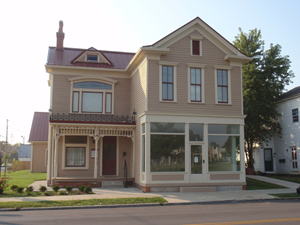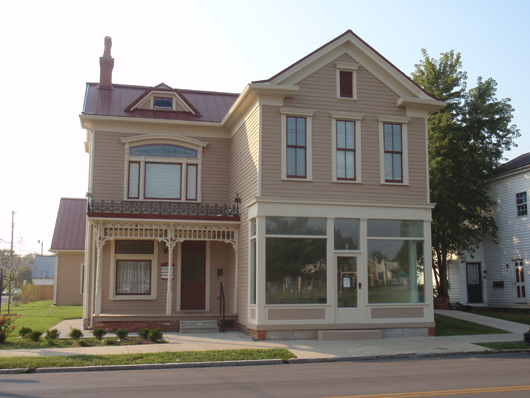
NEW ALBANY, Ind. (AP) – One of the first projects Greg Sekula took on as director of the Historic Landmarks of Indiana Southern Office was to purchase and help save Cardinal Joseph Ritter’s birthplace at 1218 E. Oak St. in New Albany.
It was a tall order indeed.
The house, which was bought for $25,000 by Historic Landmarks, was unstable and in shambles. But thanks to Sekula, David Hock and others dedicated to preserving the home and turning it into a place where those in need could receive services or gather as a community, the journey is nearly complete. Like Ritter, this group didn’t let a few bumps in the road deter their mission.
“It’s been a very rewarding endeavor,” Sekula told the News and Tribune “It’s been a long road and exceeded my own expectations.”
The front section of the house is occupied by four nonprofits – Home of the Innocents, New Directions, Elder Serve Home Care and Information Link of Southern Indiana – and the community room in the rear of the structure is used for meetings or special events. The only incomplete portion is the middle area, which is being turned into a museum and will soon have photos and artifacts to help tell the story of Ritter, the only Indiana native to ever be elevated to a cardinal in the Catholic Church.
“It’s kind of like a dream come true in slow motion,” said Hock, president of the Ritter Birthplace Foundation, who has been instrumental in the house’s rebirth. “People have been so committed to this project. We’re just now starting to talk about how any of us can get off the board. This group has been determined to see this through.”
While buying the shell of the house cost only $25,000 in 2002, Hock estimates that to date, $750,000 has been spent through cash donations and in-kind services to rehabilitate the structure. It will take a few more thousand to finish the museum, although the walls and floor have been rehabilitated in the area and are awaiting photos and other memorabilia. A lot of the museum work will be done in-house.
Ritter, who was born in the house in 1892, attended St. Mary’s Catholic Church and School in New Albany and was ordained a priest in 1917. He became the first Archbishop of Indianapolis and later became Archbishop of St. Louis, where he integrated parochial schools in 1947, just as he had done in Indianapolis. He was elevated to cardinal in 1961 and died in 1967.
The Cardinal Ritter Birthplace Foundation was founded in 2004. Hock said the house has become everything the board had envisioned it would become and more. The community center has hosted gatherings, like the one held recently commemorating the 50th anniversary of the Second Vatican Council. Timothy P. O’Malley, director of the Notre Dame Center for Liturgy, spoke about the important role Ritter played in the Second Vatican Council at the event.
Hock said the house has truly become a community project with donations of both funds and labor coming from all over. The Horseshoe Foundation of Floyd County gave the project a major boost with grants early in the process.
“The bricks and mortar are done. Now it’s how are we going to set up the displays and tell his story,” Hock said.
The board received some input on putting the museum together from Troy McCormick, and now Sekula, Ray Day and the Rev. Troy Overton will help organize and plan the museum area.
“We are trying to get the biggest bang for the buck,” Sekula said. “The shell of the area is done, we just need to add exhibits.”
Sekula hopes the museum area can open July 20, which is Ritter’s 121st birthday.
“He would probably be humbled by the attention,” Sekula said of Ritter. “He is certainly someone who should be looked up to as a model.”
Hock said the recent attention given to a new pope being elected has also drawn more attention to Ritter’s birthplace. He said he has heard people of all faiths talk about the process and the excitement of the election of Pope Francis.
“A lot of people don’t know who Cardinal Ritter was because he moved out of the area after eighth grade,” he said. “A lot of people want to know, ‘Who was this guy?’ They are asking a lot of questions.”
He said the process to complete the house has taken several years because none of the board members were “fund raisers.” Hock also said Ritter would be pleased with the final product.
“He wouldn’t care about the museum. He was all about outreach … his home has nonprofits who are reaching out to help people,” Hock said. “He would be proud of that.”
___
Information from: News and Tribune, Jeffersonville, Ind., http://www.newsandtribune.com
Copyright 2013 Associated Press. All rights reserved. This material may not be published, broadcast, rewritten, or redistributed.
AP-WF-03-28-13 1504GMT
ADDITIONAL IMAGE OF NOTE



